- Around 600 million Africans lack even basic access to electricity.
- The challenges this deficit poses have led to a call for a “just” energy transition that brings access to energy from renewable sources without imposing undue costs on individuals, communities and countries.
- The rising concentrations of CO2 in the atmosphere are largely the result of fossil fuel burning in industrialized countries, and yet countries in Africa and elsewhere in the Global South are often on the frontlines of the impacts of climate change, including unbearable heat, droughts and flooding.
- The debate about how to facilitate a “just” transition includes questions around the continued use of fossil fuels, nations’ sovereignty, and mobilizing funding to finance the necessary changes.
When two …
- Around 600 million Africans lack even basic access to electricity.
- The challenges this deficit poses have led to a call for a “just” energy transition that brings access to energy from renewable sources without imposing undue costs on individuals, communities and countries.
- The rising concentrations of CO2 in the atmosphere are largely the result of fossil fuel burning in industrialized countries, and yet countries in Africa and elsewhere in the Global South are often on the frontlines of the impacts of climate change, including unbearable heat, droughts and flooding.
- The debate about how to facilitate a “just” transition includes questions around the continued use of fossil fuels, nations’ sovereignty, and mobilizing funding to finance the necessary changes.
When two Mongabay reporters visited the village of Lukwangulo in the Democratic Republic of Congo, they encountered a reality that’s common in many parts of rural Africa: Families spend valuable time harvesting wood from forests for cooking, often their primary — and sometimes their only — source of energy. Some manage to pull together enough money for a solar panel that might charge a cellphone, power a radio and provide a little light for children to study by. But it’s typically not enough for the basic task of cooking.
The stark contrast between this situation and the broader world that runs on that energy is readily apparent to those who currently have little to no access to it.
“You come from the city — you have electricity, you have lighting. Why you and not us?” Mukalay Ngoyi, a leader from Lukwangulo, told Mongabay. “We’re human beings like you, and we need electricity too.”
On Nov. 10, delegates to the U.N.’s annual climate conference, COP30, will meet in Belém, Brazil, to assess global progress toward addressing climate change by limiting carbon emissions. Key to drawing down those emissions and achieving the goal of keeping the global temperature rise well below 2° Celsius (3.6° Fahrenheit) above pre-industrial levels is how we meet growing energy demand, both around the globe and in places like Lukwangulo.
But most community leaders won’t be in Belém, instead relying on others to make the case for a “just” energy transition.
The “just” concept “means leaving no one behind,” Elbia Gannoum, a COP30 special envoy and executive president of the Brazilian Wind Energy and New Technologies Association (ABEEólica), said in recent comments ahead of the conference. “We cannot pursue this transition at the expense of society, jobs, or people’s livelihoods. We must move forward while ensuring that the economy and society advance together.”
 A woman carrying firewood in Laikipia county, Kenya. Image © FAO/Luis Tato.
A woman carrying firewood in Laikipia county, Kenya. Image © FAO/Luis Tato.
In the DRC and elsewhere, relying on wood for routine energy needs poses significant problems, from degrading some of the most biodiversity-rich forests on the planet to causing health issues, especially for women. And sources of energy like electricity that could replace some or all of households’ need for wood and charcoal are limited. Across the continent, some 600 million Africans lack any access to electricity, a versatile source of energy.
On the one hand is the pressure to bring more reliable and affordable electricity access to the continent. This includes efforts like Mission 300, an initiative of the African Development Bank and the World Bank with a goal of expanding electricity to 300 million people in Africa by 2030, in part through the development of clean energy sources.
On the other hand, though, is the knowledge that continuing to develop fossil fuel-driven power sources will add to the mounting effects of climate change, often affecting the world’s least-industrialized countries most profoundly. In Côte d’Ivoire, for example, farmers facing droughts and floods struggle to meet the demand for staples like cassava and tomatoes.
Seven of the 10 countries most vulnerable to the impacts of climate change are in Africa, according to the Notre Dame Global Adaptation Initiative. The initiative assesses the threats to countries posed by climate change and how ready they are to meet them.
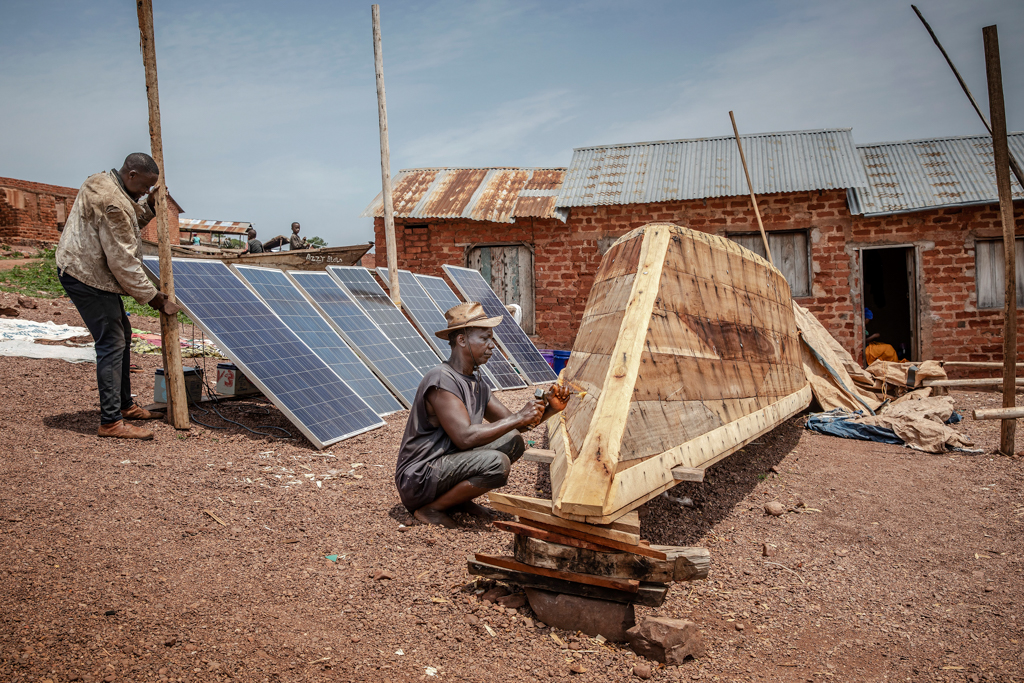 Solar panels charge batteries as a man fixes a traditional fishing boat near Lake Tanganyika in Kigoma, Tanzania. Image © FAO/Luis Tato.
Solar panels charge batteries as a man fixes a traditional fishing boat near Lake Tanganyika in Kigoma, Tanzania. Image © FAO/Luis Tato.
Beyond the issue of household access, entire economies lack the power they need to support the development of industry. The problems are set against a backdrop of the intertwined tensions of domestic politics and international relationships, and complicated by a legacy of inequality that favors Global North countries.
People in places like Lukwangulo in the DRC contribute a tiny fraction of the carbon that’s warming the planet. Africans are responsible for 3.8% of the CO2 in the atmosphere, while the continent is home to 18.3% of the world’s people — around 1.5 billion people in 2024.
In contrast, Global North countries owe their industrialization and economic development to nearly two centuries of burning oil, gas and coal. Moreover, wealthy nations continue to contribute disproportionately to climate change.
Perhaps the most glaring example is the United States, which has added more CO2 to the atmosphere than any other country in history. Under President Donald J. Trump, the U.S. has turned its back on the Paris Agreement (for a second time), embraced fossil fuel exploitation, abandoned subsidies for solar and other renewables, and scaled back wind power projects.
For their part, some African countries, which have much lower per capita emissions than the U.S., have embraced greener energy. For example, the proportion of electricity from renewable sources is nearly 40% in Ghana, and around 90% in Kenya. Proponents of a just transition for Africa point to the seemingly limitless potential for low-carbon power that Africa seems to offer. Ideally, they argue, investment in the continent’s abundant sources of solar, wind and geothermal power could meet most of the continent’s energy needs, from charging phones to powering the essential services provided by schools, hospitals and communications networks.
According to these experts, expanded access to energy — and energy that is clean — may seem within reach for the millions who lack it and the countries in which they reside. And yet, as Gannoum points out, achieving that goal requires careful planning to make sure that the transition doesn’t impose undue costs on the people who need the energy the most.
Not just a transition
The success of this transition depends not only on technological and infrastructure advances, but also on the political will of African leaders and the support of the people most impacted. But as researchers note, even the word “transition” is out of place in many contexts.
“When we’re talking about the energy sector in Africa … we’re often talking about energy development,” says Emma Gordon, an energy investment policy analyst with the International Energy Agency (IEA) and co-author of a recent report, “Financing Electricity Access in Africa.” Many people lack access altogether, and those who have it may not have enough, Gordon adds.
Elsewhere, South Africa, the continent’s largest economy, where around 90% of the population has access to electricity, is wrestling with how to green an energy system dominated by coal. The South African government has laid out a Just Energy Transition Investment Plan for reducing its reliance on carbon-intensive energy sources. (Around 85% of its electricity currently comes from coal-fired power plants.) South Africa is also part of a Just Energy Transition Partnership (JETP) aimed at providing financing from the Global North to help the country move toward cleaner energy sources.
Still, its aging power infrastructure doesn’t produce enough electricity. In South Africa, the transition is bedeviled by the question of why South Africans, frustrated by frequent blackouts, should support phasing out coal plants that might disrupt their nation’s ability to produce energy.
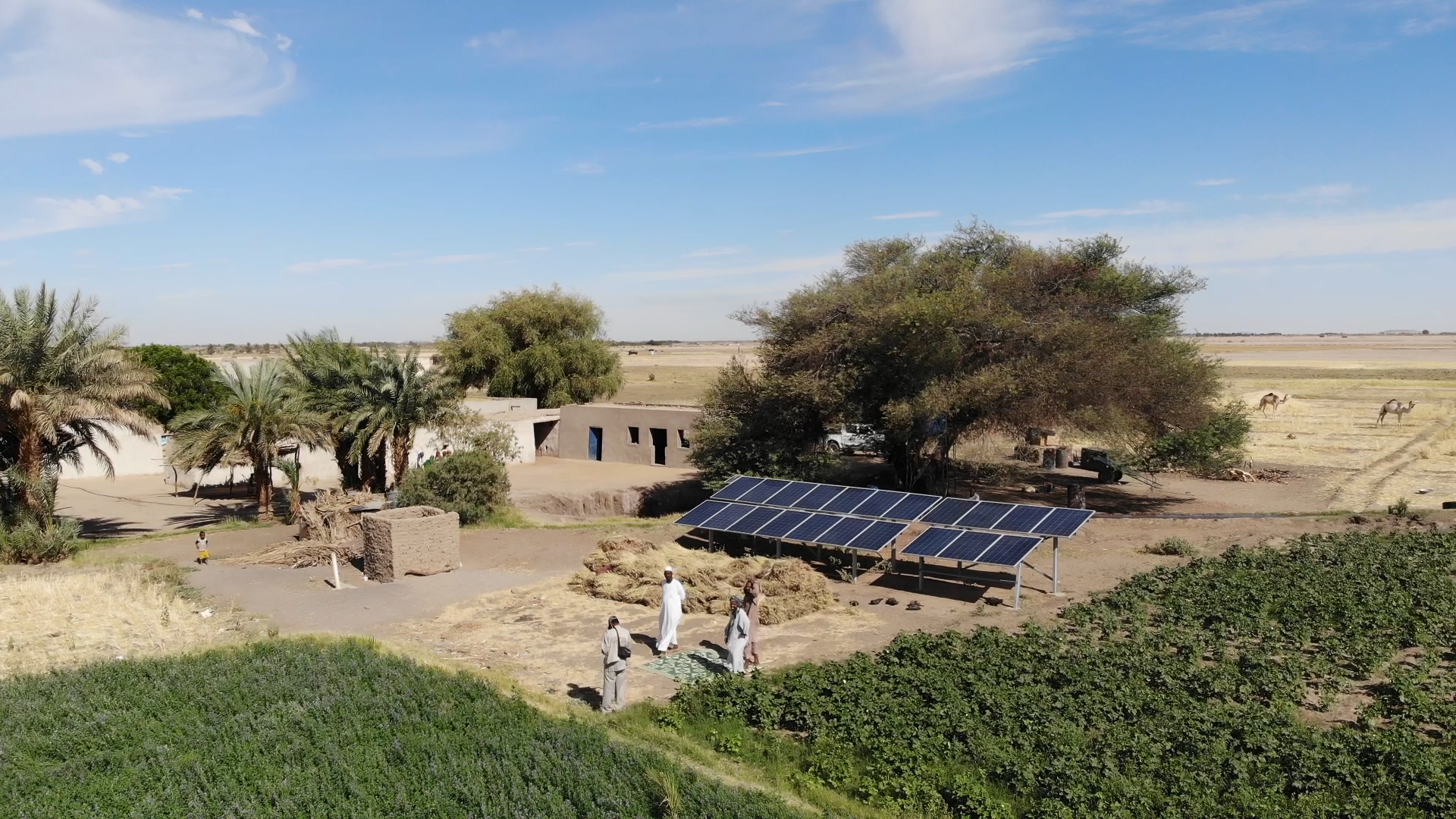 Solar panels power pumps in Sudan. Image © UNDP Sudan/Muhanad Sameer via Flickr.
Solar panels power pumps in Sudan. Image © UNDP Sudan/Muhanad Sameer via Flickr.
“You’re not going to convince people to close down generation,” says Alexander Csanadi, a former research analyst at the Carnegie Endowment for International Peace, a Washington, D.C.-based think tank, who wrote a recent paper on the future of the JETPs. “It doesn’t make sense at some level.”
What’s more, coal workers and their communities in South Africa face the loss of their livelihoods, along with a social fabric that’s tied in with “a political and historical identity,” says Karabo Mokgonyana, a renewable energy campaigner based in South Africa with Kenya-based Power Shift Africa.
Without ensuring reliable, convenient and affordable energy access across the continent while also addressing the attendant issues, the prospect of a successful transition risks foundering, according to experts.
In essence, what are the costs that embracing renewable energy imposes on communities and economies in Africa? And will Africans and African leaders have the appetite to transition fully to renewables when they could more readily use fossil fuels, as wealthy countries have done?
But alongside the challenges of replacing fossil fuels with renewables is the potential to grow economies and raise standards of living, proponents argue. Putting robust renewables infrastructure in place could, for example, improve energy access and reliability, they say.
Sovereignty and stranded assets
In places like Lukwangulo, investments in solar panels aren’t seen as a viable solution for cooking because the task requires more energy than many power solutions in rural areas can provide. In such contexts, liquefied petroleum gas (LPG), often packaged in large, portable canisters, can be a ready alternative to cooking with wood — and one that even staunch supporters of a move to renewables may see a role for.
“[LPG] distribution offers a simpler route to reaching homes, households and public institutions … that are far from grid,” says Rebekah Shirley, deputy director for Africa at the World Resources Institute (WRI).
For some, the energy deficit in Africa supports arguments for continuing to develop fossil fuels, including liquefied natural gas (LNG), and continuing to use LPG, a byproduct of oil refining and natural gas processing, for cooking.
“Our approach is not to choose between fossil fuels and renewables, but to strategically integrate both to power growth, jobs and resilience,” said John Abdulai Jinapor, Ghana’s minister of energy and green transition, at Africa Energy Week in South Africa, according to the publication GhanaWeb. Nearly 60% of Ghana’s electricity comes from natural gas, according to the IEA.
Fossil fuel industry representatives — and current U.S. Secretary of Energy Chris Wright, who has led oil and gas companies for decades — use similar arguments to advocate for the role of fossil fuels in Africa.
 Solar panels used to produce electricity to operate the irrigation system of a farm in Mauritania. Image © FAO/Giulio Napolitano.
Solar panels used to produce electricity to operate the irrigation system of a farm in Mauritania. Image © FAO/Giulio Napolitano.
But Fadhel Kaboub, an associate professor of economics at Denison University in the U.S., sees an analogy in the transition to automobiles in the early 20th century. “It’s as if … somebody comes to you and says, ‘Look, you’re a sovereign nation. You have all these horses and all these trees. You should double down your investments in the horse-and-cart industry and let the rest of the world leapfrog into the Industrial Revolution with a new mode of transportation,” he says. “That’s precisely what the fossil fuel companies are doing.”
LNG is often seen as a potential bridge fuel. But burning LNG pumps more carbon than renewables into the atmosphere, says Rajneesh Bhuee, a campaign manager with Netherlands-based nonprofit Recourse. What’s more, she adds, these projects run the risk of harming the environment and displacing communities.
Echoing Kaboub’s point, Bhuee also says that gas- and oil-focused infrastructure costing African countries billions of dollars will become obsolete in a matter of decades as wealthy countries shift to renewables. That would leave behind what are known as “stranded assets.”
“They’ll probably be investing in [electric vehicles] and batteries,” Bhuee adds. “We’ll be stuck here with pipelines, and no one will buy from us.”
An energy powerhouse
Many backers of a renewable-focused transition argue that continuing the use of any fossil fuels, including LNG, doesn’t make economic sense. They note that renewable infrastructure is increasingly affordable, and the continent has vast untapped sources of green energy. A 2021 IRENA report estimated that the continent could produce 1,000 times its energy needs by 2040 using technology already available today.
“It’s precisely because we have the right to development, and precisely because we have the sovereignty to decide which energy system we want to use, that we shouldn’t use the old energy system that has never delivered energy security,” says Kaboub, who is Tunisian-American. “We should leapfrog into the new energy system.”
 A young girl preparing a meal for herself and her brother during the lunchbreak in Kenya. Image © FAO/Sarah Elliott.
A young girl preparing a meal for herself and her brother during the lunchbreak in Kenya. Image © FAO/Sarah Elliott.
Several African countries are making progress in boosting access to renewable electricity for their people. In West Africa’s Benin, access has increased to around 43% of rural households in recent years. That’s much higher than in the DRC, though still low compared to 84% for rural areas globally. But the country is reporting some success with the installation of solar-powered mini-grids, which generate power for communities beyond the reach of main power grids.
With so much renewable potential available and so much growing demand for power on the continent, why then is the transition to carbon-free power such a struggle?
Most experts agree that the current state of technology for harnessing renewable sources is not the problem. The technology has evolved, and there’s still progress being made, even to address the needs of communities like Lukwangulo in the DRC.
“There’s so much innovation happening in cooking,” Shirley says. “The technology is no longer the issue.” But many households may not be able to afford the new technology or the power to run it unless there are subsidies or some other form of support, she adds. In part, that’s due to the lack of industry.
Without industrial uses generating higher demand, there’s less incentive for investors to take the initial plunge required to set up power generation and distribution infrastructure.
“What do you do first? Do you create the demand base that doesn’t have the power that it needs? Or, do you invest in the power that will, for some time, not have the off-takers that it needs to pay for itself?” Shirley adds, outlining the conundrum. “What that does is creates a real challenge financially. It means it’s very difficult to build financial models that work for the continent.”
When the investments in building out energy infrastructure do come, however, they will likely encourage a cycle of growth, according to the IEA.
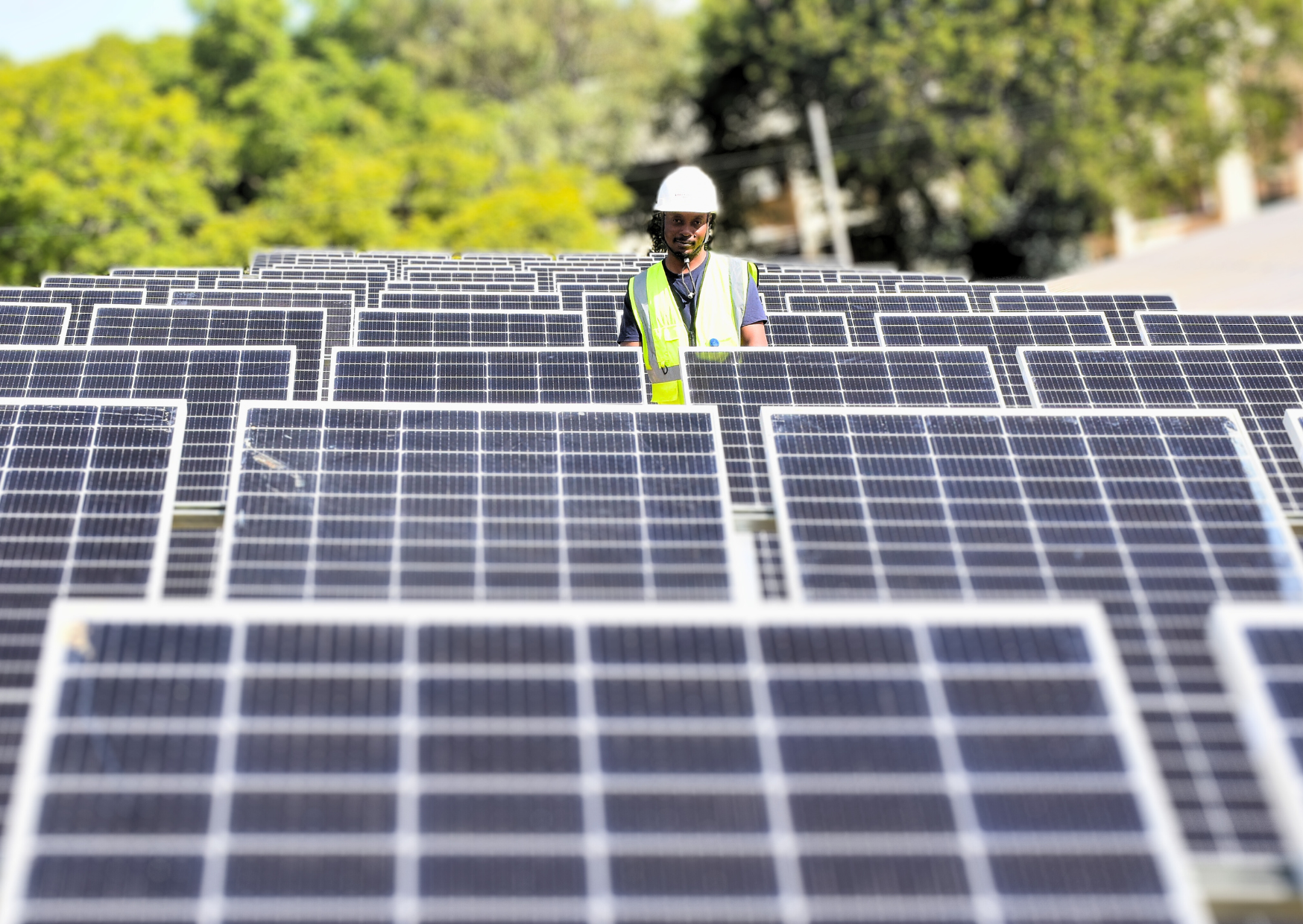 A technician inspects an array of solar panels in Lilongwe, Malawi. Image © Florence Leysen/UNDP Malawi via Flickr.
A technician inspects an array of solar panels in Lilongwe, Malawi. Image © Florence Leysen/UNDP Malawi via Flickr.
“It’s not something that we see that won’t pay for itself,” says Adam Ward, an energy and investment policy analyst with the IEA and a co-author of the report on financing electricity access. “It’s a basic human right to have access to electricity, but it’s also something that will bring economic benefits,” including increased incomes.
“We’ve seen that across so many other countries,” Ward adds, “and we are seeing it now across Africa.”
The key to unlocking those benefits then becomes how to encourage initial investments, which he and his colleagues address in their report. By their calculations, Africa needs $15 billion a year over the next 10 years to reach universal electricity access.
Yet, the proportion of clean energy investments reaching the continent is no more than a tiny fraction of what’s plowed into the sector globally, says Power Shift Africa’s Karabo Mokgonyana, because of the perception of the risks and the difficulties in scaling up that energy.
There’s little doubt that the sheer volume of financing must increase. South Africa’s JETP currently comes with an $8.5 billion pledge of financing, but that falls far short of the nearly $100 billion the country’s leaders estimate they need for a successful transition.
Increasing access will mean “being smarter with the money that we have,” Ward says.
Shirley argues that “the challenge of energy transition” must be solved across local, national and international levels. “There’s not one silver bullet,” she says. “More solar on the continent isn’t a solution. Pumping more money alone isn’t a solution. We sort of need this real systems-level thinking about the energy transition challenge.”
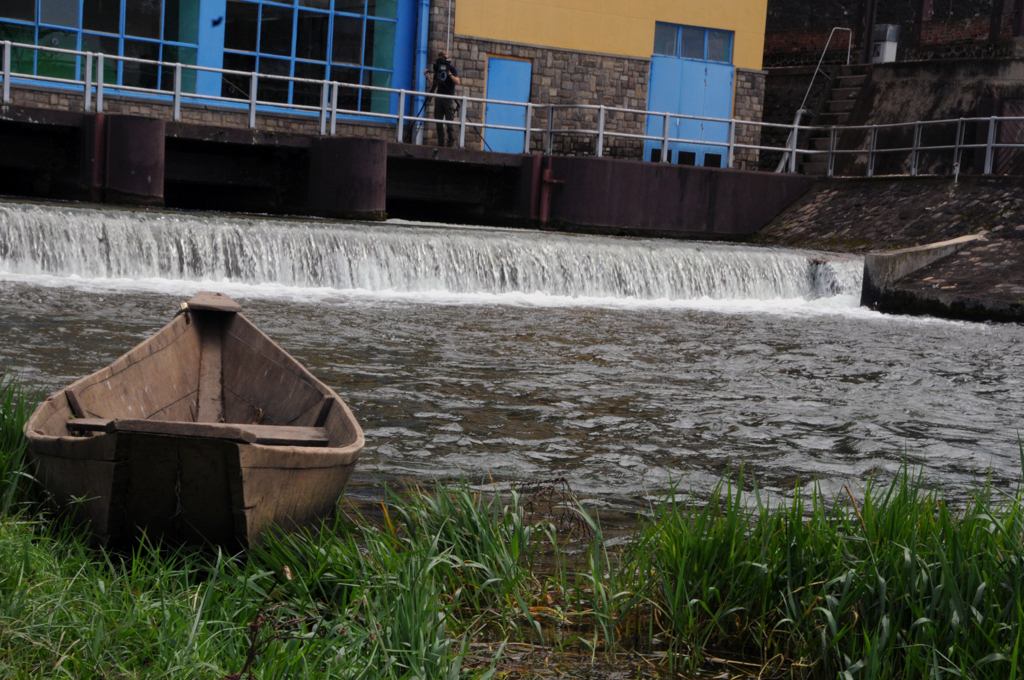 Solar panels used to produce electricity to operate the irrigation system of a farm in Mauritania. Image © FAO/Giulio Napolitano.
Solar panels used to produce electricity to operate the irrigation system of a farm in Mauritania. Image © FAO/Giulio Napolitano.
‘The perfect ingredients’
Shirley highlights a potential model for addressing the question of where to begin in relation to supply and demand. In Kenya, for example, WRI is working with counties to increase the energy necessary for the dairy supply chain, which requires cold-chain storage. Generation might start with a solar project that ties into the main grid, Shirley explains, and that’s seen as an attractive investment for financiers because there’s already existing demand for dairy products.
The idea is to get renewable energy flowing and boost commercial demand. “Then, the economics for providing and serving households is almost a byproduct,” she says. “It becomes something that’s very easy for a service provider to deliver.”
The broader aim is to develop not just robust green energy systems, but entire “thriving, shock-resistant economies” that are self-sustaining.
“You build waves of jobs, you build resilience into [the] community, all while maintaining a path that is very low-carbon,” Shirley adds. “The continent has the perfect ingredients to achieve that big vision.”
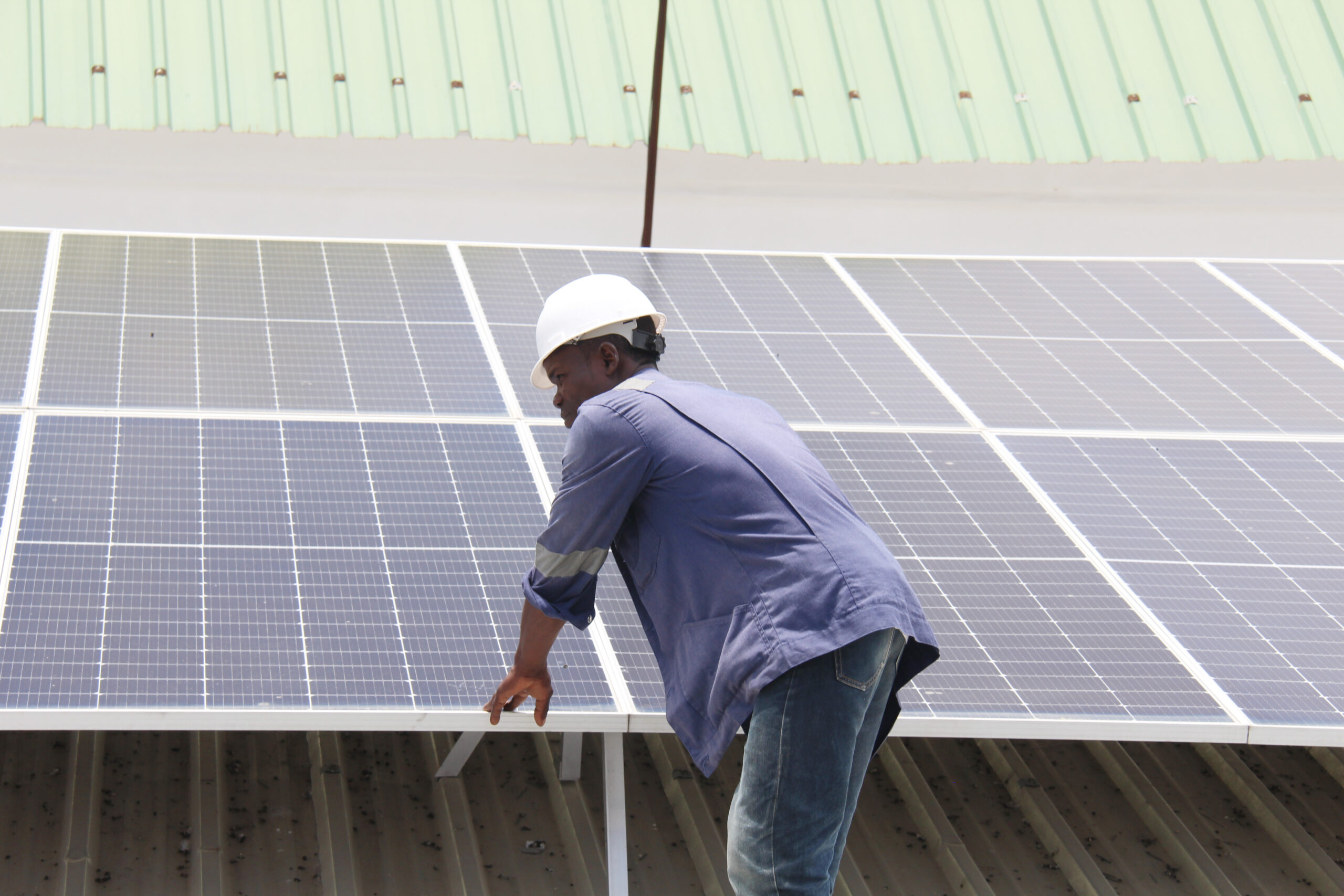 An engineer with solar panels in Cotonou, Benin. Image © UNDP Benin via Flickr.
An engineer with solar panels in Cotonou, Benin. Image © UNDP Benin via Flickr.
Belinda Mongolare and Didier Makal contributed reporting.
Banner image: Technicians in Zimbabwe inspect solar panels. Image © UNDP Zimbabwe. (UNDP Zimbabwe 54585295677_0caffd97bb_o)
***John Cannon *is a staff features writer with Mongabay. Find him on Bluesky and LinkedIn.
**Citation: **
Peters, R., Berlekamp, J., Kabiri, C., Kaplin, B. A., Tockner, K., & Zarfl, C. (2024). Sustainable pathways towards universal renewable electricity access in Africa. Nature Reviews Earth & Environment, 5(2), 137-151. doi:10.1038/s43017-023-00501-1
Smallholder agriculture blossoming with the use of renewables in Africa
**FEEDBACK: **Use this form to send a message to the author of this post. If you want to post a public comment, you can do that at the bottom of the page.